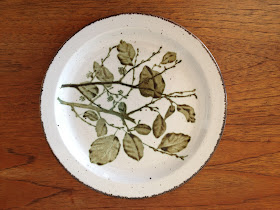If you read my last post, this is what's behind that belt of sanddunes. When you cross the dunes you leave the windswept beach and enter a sheltered green area where you can still smell the salty North sea, but also an intense smell of grass and straw, and there's the chirping and humming of birds and insects.
I wanna show you a piece of great design and an outstanding piece of well adjusted architecture. I never thought I could fall in love with bicycle parking, but this one is something else. Inspired by the straw growing in the dunes,
it looks like a great abstract scupture. Not so sure about the
functionality, though, but I tend to choose beauty over it. It was a
project for Jæren Friluftsråd (not sure how to translate that, but
it's an organization that is responsible for the preservation of the
Jæren landscape), and I know you can find them on two other beaches,
maybe more.
This
particular piece of great design is located in the area behind the
dunes to accomodate beachwalkers arriving by bike. On one of the most
beautiful of the Jæren beaches, it's situated in the opposite end from
where my aunt has a small cabin, which I wrote about in
this post.
The dunes are in constant movement. In the 1800s, many farms were
endangered by sand being blown over the fields. A belt of straw was
planted to keep the sand in place and this caused large dunes to build
up. Today, the area behind the dunes is sheltered and very fertile.
Where there are not farms, there are all kinds of wild flowers and a
large amounts of birds and insects. The beaches here in the southwest of Norway are where the migrating
bird are seen first when they come back in the early spring.
Next to the bicycle parking is Friluftshuset, a beautiful piece of architecture designed by local architect Per Line. It was built in 1987 and extended in 1992. It burned to the
ground in 1999, but was raised again excactly like it was. Line sadly died in 1997, only 61
years old. He was greatly admired for his interpretation of the
traditional Jæren architecture and landscape features in his buildings.
This building is concidered his most important work. He did some beautiful renovations and additions to old buildings too, one of
them a wonderful old vicorage turned into an art gallery.
Friluftshuset is an exhibition/ information center for the preservation of the local flora, fauna and landscape. There is a lot of information about the protected landscape and how we can help preserving it, as well as the prosesses that has shaped it, from the ice age and up until now. It has a sheltering atrium serving as a picnic area or just a refuge on
windy days. Each summer, a local artist is invited to exhibit his or her
work for a period from march to october.
The building is in Nordic "humane modernism", a reaction to the non- compromising style of modernism. Line worked for Knut Knutsen at the beginning of his career, whose cabin in Portør, inspired a whole generation of architects.
The building is a perfect "answer" to the surrounding landscape. It refers to local phenomena, the traditional groundhugging architecture, the driftwood, the irregular and flowing shape of the dunes. Like it or not, you gotta admit it´s well adjusted to it´s surroundings, right?
Cool car full of dutch surfers, notice the color match?
Traditional houses in Jæren were placed along the prevailing wind
direction, facing the sea, and both ends extended towards the ground
to let the wind pass easily over them. In both ends there were peet
storage for (fyring), peet because the stoney stretch of coast had no
natural forests. The peet storage also helped insulate the house.
Life
was all about the sea. The facades had windows towards it, the other
sides were sheltered by stone walls, a bit similar to historic houses on
the Orkneys, Shetland and Faroe islands. As the import of wood from the
inland parts of the country was made
possible, more of the facades got wood cladding, while you could pick
out poor people's houses by the amount of stone... There are very few
really old houses left
in this area. Can you imagine why? The little wood materials people had
were used again to build new ones. Even timber from shipwrecks were
used.

Back to Per Line's masterpiece. The weathered surfaces, the ruggedness and the way it sits in the landscape reminds me a lot of Sea Ranch by architects Charles Moore, Donlyn Lyndon,
William Turnbull, and Richard Whitaker, built in the 60s on a piece of rugged Californian coast. This might also very well have been a source of inspiration to Line. If you don´t know it already, look it up- it´s a wonderful peace of architecture in an amazing landscape.
Sadly, the atrium and interior was closed the day we visited, due to a private arrangement. However, I have this great catalogue from a Per Line exhibition that has some beautiful pictures of the atrium and how the landscape looks like in the late fall and winter.There are also the plans, including the roof plan, to give you a better understanding of it.

















.JPG)
.JPG)


.JPG)






















































